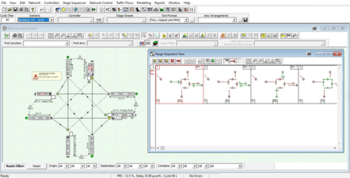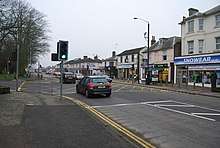LinSig
LinSig is a software tool by JCT Consultancy which allows traffic engineers to model traffic signals and their effect on traffic capacities and queuing.[1] As well as modelling the effects of traffic signals LinSig also optimises signal timings to reduce delay or increase capacity at a junction or group of interlinked junctions.[2][3]
 LinSig 3 under Windows 10 | |
| Developer(s) | JCT Consultancy |
|---|---|
| Stable release | 3.0
/ June 2009 |
| Operating system | Windows |
| Type | Traffic Software |
| License | Software license agreement |
| Website | http://www.jctconsultancy.co.uk |

History
LinSig was developed in the UK by Brian Simmonite in the 1980s who went on to set up JCT Consultancy. The software has been updated a number of times during its life.
DOS Versions
LinSig was first written in the mid-1980s as a DOS-based tool for analysing and optimising single traffic signal junctions. The use of the software spread mainly by word of mouth within the traffic signals profession becoming widely used by signal engineers. The LinSig traffic modelling was based on standard 'Y' value hand calculations[4] which were widely used at the time for manually calculating traffic signal capacities and delays. This allowed the results of the software to be easily checked against existing manual calculations.
LinSig for Windows Version 1 - Released March 2000
LinSig for Windows Version 1 retained the same modelling capabilities as the earlier DOS versions but provided a Windows interface. This version also introduced graphical diagrams into the software showing information such as the junction's lane layout and the phasing and staging arrangements.
LinSig Version 2 - Released April 2006
LinSig Version 2 was the first version of LinSig to allow the modelling of more than one junction.[5] A new network traffic model was introduced which allows the coordination of closely spaced traffic signal junctions to be modelled.
LinSig Version 3 - Released June 2009
LinSig 3 changed from a link-based model to a lane-based model.[6] It also allowed the user to model larger networks and provides new network modelling tools such as delay-based traffic assignment and entropy-based trip matrix estimation. Using this software it is possible to model signalised roundabouts.[7]
Modelling Basis
LinSig uses a development of the Cyclic Flow Profile traffic model which has been used extensively in the UK for many years. The Cyclic Flow Profile Model simulates the interaction between closely space junctions allowing coordinated signal timings to be modelled.
Typical Input data
LinSig input data includes observed traffic flows, traffic signal controller phases and stages, intergreen times[8], saturation flows[9] and lane lengths.
Pedestrian Modelling
Pedestrian delays at signal junctions can be modelled for individual or linked crossings.
Signal Optimisation
LinSig optimises signal timings either to maximise traffic capacity or minimise delay at a junction.
Network Modelling
LinSig can model and optimise networks of several junctions as well as individual junctions. It is designed to model small groups of junctions in detail rather than larger networks covering entire towns.
Delay Based Assignment
LinSig uses a traditional user equilibrium assignment to assign traffic to routes through the network based on delays calculated by the network model.
Matrix Estimation
LinSig provides a matrix estimation facility to generate a network wide trip matrix from junction turning counts. This uses a combination of traditional entropy-based estimation methods together with customisations targeted at estimating matrices in smaller networks.
Alternative Solutions
The main competitor within the UK marketplace is TRANSYT.
References
- http://www.jctconsultancy.co.uk/Support/documentation.php LinSig Manual. JCT Consultancy. June 2009. Paul Moore
- TfL Traffic Modelling Guidelines v3 http://content.tfl.gov.uk/traffic-modelling-guidelines.pdf
- Bolsover Town Transport Study https://www.bolsover.gov.uk/images/LIVE/P/Plan_EB_BolsTTSreport_1610.pdf
- Bangladesh Roads and Highways Department - Paragraph 5.30 http://www.rhd.gov.bd/Documents/ExternalPublications/Trl/Calculation%20of%20traffic%20signal%20timings-Webster's%20method%20Note13.pdf http://www.rhd.gov.bd/Documents/ExternalPublications/Trl/Calculation%20of%20traffic%20signal%20timings-Webster's%20method%20Note13.pdf
- http://www.jctconsultancy.co.uk/Home/docs/JCT_LINSIG2_Joined_Up_Modelling_TEC_Article_Sep2006.pdf Joined Up Traffic Modelling with LINSIG V2. TEC Journal. September 2006. Paul Moore
- JCT Consultancy, LINSIG 3 User Guide
- http://www.jctconsultancy.co.uk/Home/docs/JCT_LinSig_for_Signalled_Roundabouts_Symposium_2007.pdf LinSig for Signalled Roundabouts. JCT Symposium, Nottingham, September 2007 Dr. Douglas Reid, Brian Simmonite
- Traffic Signs Manual Chapter 6 https://assets.publishing.service.gov.uk/government/uploads/system/uploads/attachment_data/file/851465/dft-traffic-signs-manual-chapter-6.pdf
- http://www.trl.co.uk/online_store/reports_publications/trl_reports/cat_traffic_engineering/report_the_prediction_of_saturation_flows_for_single_road_junctions_controlled_by_traffic_signals.htm Research Report 67 - The prediction of saturation flows for single road junctions controlled by traffic signals, Kimber, TRL